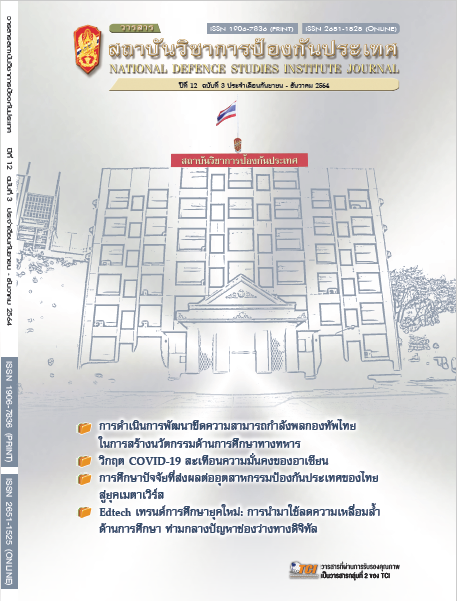Factors Affecting Employees' Engagement of the Staff in Navaminda Kasatriyadhiraj Royal Air Force Academy -
Main Article Content
Abstract
In this research investigation, the researcher examines 1) the level of employees’ engagement of the staff at Navaminda Kasatriyadhiraj Royal Air Force Academy (NKRAFA); compares 2) the employees’ engagement of the staff under study classified by personal factors; and investigates 3) the quality of life factors affecting the employees’ engagement of the staff under investigation.
The sample population was 253 subjects from NKRAFA from the total population which are 684 persons. The research instruments were an interview form and a questionnaire eliciting the quality of work life and employees’ engagement. The statistics used in data analysis were frequency, percentage, mean, and standard deviation. The techniques of t test, one-way ANOVA, and multiple linear regression analysis were also employed.
Findings are as follows: 1) The staff under study exhibited employees’ engagement at a high level. 2) The comparison in accordance with the personal factors of the staff under investigation found that differences in the salary level exhibited differences in the perception of employees’ engagement. Differences in the variables of gender, age, employment period, work status, and affiliations exhibited no differences in the perception of employees’ engagement at the statistically significant level of .05. 3) The factors of the quality of work life affecting the employees’ engagement of the staff under investigation at the statistically significant level of .05 consisted of the development of human capacities and social relevance. These two factors could predict the employees’ engagement of the staff under study at 49 percent (R square 0.490).
Article Details

This work is licensed under a Creative Commons Attribution-NonCommercial-NoDerivatives 4.0 International License.
The articles, images, tables, graphs, written content, and opinions published in this journal are solely those of the authors and do not necessarily reflect the views or positions of the National Defence Studies Institute or its academic affiliates.
References
กองทัพอากาศไทย. (2561). ยุทธศาสตร์กองทัพอากาศ 20 ปี (พ.ศ.2561-2580) ฉบับเผยแพร่. กรุงเทพฯ: กองทัพอากาศ.
ชัยวัฒน์ โอสถอํานวยโชค. (2555). ปัจจัยจูงใจที่มีความสัมพันธ์กับความผูกพันต่อองค์การของพนักงานบริษัทที่ปรึกษาด้านระบบคอมพิวเตอร์ กรณีศึกษาพนักงานบริษัทที่ปรึกษาด้านระบบคอมพิวเตอร์แห่งหนึ่ง (สารนิพนธ์บริหารธุรกิจมหาบัณฑิต). มหาวิทยาลัยศรีนครินทรวิโรฒ.
ธงชัย สันติวงษ์. (2540). องค์กรและการจัดการทันสมัยยุคโลกาภิวัตน์. กรุงเทพฯ: ไทยวัฒนาพานิช.
ปรียาภรณ์ อยู่คง. (2558). คุณภาพชีวิตการทำงานของข้าราชการทหารในจังหวัดเพชรบุรี (วิทยานิพนธ์รัฐประศาสนศาสตรมหาบัณฑิต). จุฬาลงกรณ์มหาวิทยาลัย.
พลอยบุษรา บุญญาพิทักษ์. (2558). คุณภาพชีวิตการทำงานกับการรักษาความผูกพันต่อองค์การของบุคลากรต่างวัย:กรณีศึกษาบุคลากรในสำนักงานปลัดกระทรวงมหาดไทย (วิทยานิพนธ์รัฐประศาสนศาสตรมหาบัณฑิต). จุฬาลงกรณ์มหาวิทยาลัย.
ศิริชัย กาญจนวาสี, ทวีวัฒน์ ปิตยานนท์, และดิเรก ศรีสุโข. (2559). การเลือกใช้สถิติที่เหมาะสมสำหรับการวิจัย (พิมพ์ครั้งที่ 7). กรุงเทพฯ: โรงพิมพ์แห่งจุฬาลงกรณ์มหาวิทยาลัย.
โศรตี โชคคุณะวัฒนา. (2557). คุณภาพชีวิตในการทำงานที่มีผลต่อความผูกพันต่อองค์กรของพนักงานธนาคารกรุงไทย สำนักงานใหญ่ (สารนิพนธ์บริหารธุรกิจมหาบัณฑิต). มหาวิทยาลัยศรีนครินทรวิโรฒ.
อรวรรณ เปรมธีรวัฒน์ชัย และชิณโสณ์ วิสิฐนิธิกิจา. (2562). ระหว่างคุณภาพชีวิตการทำงานกับความผูกพันต่อองค์การของพนักงานบริษัท ไทยจูรอง เอ็นจิเนียริ่ง จำกัด. วารสารวิจัยและพัฒนามหาวิทยาลัยราชภัฏเลย, 14(49), 62-73.
Hewitt Associates. (2010). Hewitt Engagement Survey. Retrieved September 14, 2020 from http://www.asia.aonhumancapital.com/document-files/thought-leadership/people-and-performance/model-of-employee-engagement.pdf
Walton, R.E. (1975). The Quality of Working Life: Criteria for Quality of Working Life. New York: Free Press.


